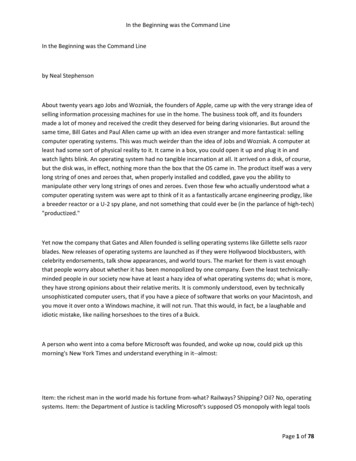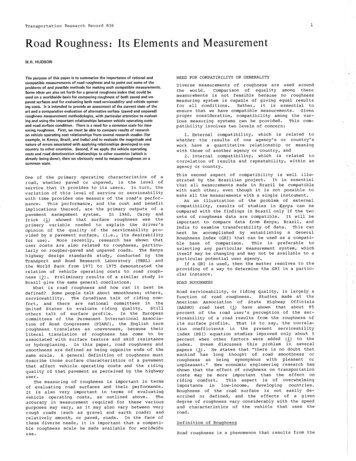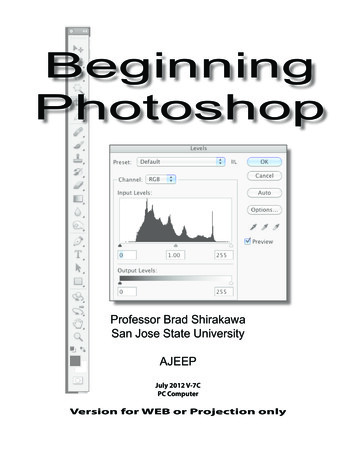
Transcription
In the Beginning was the Command LineIn the Beginning was the Command Lineby Neal StephensonAbout twenty years ago Jobs and Wozniak, the founders of Apple, came up with the very strange idea ofselling information processing machines for use in the home. The business took off, and its foundersmade a lot of money and received the credit they deserved for being daring visionaries. But around thesame time, Bill Gates and Paul Allen came up with an idea even stranger and more fantastical: sellingcomputer operating systems. This was much weirder than the idea of Jobs and Wozniak. A computer atleast had some sort of physical reality to it. It came in a box, you could open it up and plug it in andwatch lights blink. An operating system had no tangible incarnation at all. It arrived on a disk, of course,but the disk was, in effect, nothing more than the box that the OS came in. The product itself was a verylong string of ones and zeroes that, when properly installed and coddled, gave you the ability tomanipulate other very long strings of ones and zeroes. Even those few who actually understood what acomputer operating system was were apt to think of it as a fantastically arcane engineering prodigy, likea breeder reactor or a U-2 spy plane, and not something that could ever be (in the parlance of high-tech)"productized."Yet now the company that Gates and Allen founded is selling operating systems like Gillette sells razorblades. New releases of operating systems are launched as if they were Hollywood blockbusters, withcelebrity endorsements, talk show appearances, and world tours. The market for them is vast enoughthat people worry about whether it has been monopolized by one company. Even the least technicallyminded people in our society now have at least a hazy idea of what operating systems do; what is more,they have strong opinions about their relative merits. It is commonly understood, even by technicallyunsophisticated computer users, that if you have a piece of software that works on your Macintosh, andyou move it over onto a Windows machine, it will not run. That this would, in fact, be a laughable andidiotic mistake, like nailing horseshoes to the tires of a Buick.A person who went into a coma before Microsoft was founded, and woke up now, could pick up thismorning's New York Times and understand everything in it--almost:Item: the richest man in the world made his fortune from-what? Railways? Shipping? Oil? No, operatingsystems. Item: the Department of Justice is tackling Microsoft's supposed OS monopoly with legal toolsPage 1 of 78
In the Beginning was the Command Linethat were invented to restrain the power of Nineteenth-Century robber barons. Item: a woman friend ofmine recently told me that she'd broken off a (hitherto) stimulating exchange of e-mail with a youngman. At first he had seemed like such an intelligent and interesting guy, she said, but then "he startedgoing all PC-versus-Mac on me."What the hell is going on here? And does the operating system business have a future, or only a past?Here is my view, which is entirely subjective; but since I have spent a fair amount of time not only using,but programming, Macintoshes, Windows machines, Linux boxes and the BeOS, perhaps it is not so illinformed as to be completely worthless. This is a subjective essay, more review than research paper,and so it might seem unfair or biased compared to the technical reviews you can find in PC magazines.But ever since the Mac came out, our operating systems have been based on metaphors, and anythingwith metaphors in it is fair game as far as I'm concerned.MGBs, TANKS, AND BATMOBILESAround the time that Jobs, Wozniak, Gates, and Allen were dreaming up these unlikely schemes, I was ateenager living in Ames, Iowa. One of my friends' dads had an old MGB sports car rusting away in hisgarage. Sometimes he would actually manage to get it running and then he would take us for a spinaround the block, with a memorable look of wild youthful exhiliration on his face; to his worriedpassengers, he was a madman, stalling and backfiring around Ames, Iowa and eating the dust of rustyGremlins and Pintos, but in his own mind he was Dustin Hoffman tooling across the Bay Bridge with thewind in his hair.In retrospect, this was telling me two things about people's relationship to technology. One was thatromance and image go a long way towards shaping their opinions. If you doubt it (and if you have a lotof spare time on your hands) just ask anyone who owns a Macintosh and who, on those grounds,imagines him- or herself to be a member of an oppressed minority group.The other, somewhat subtler point, was that interface is very important. Sure, the MGB was a lousy carin almost every way that counted: balky, unreliable, underpowered. But it was fun to drive. It wasresponsive. Every pebble on the road was felt in the bones, every nuance in the pavement transmittedinstantly to the driver's hands. He could listen to the engine and tell what was wrong with it. Thesteering responded immediately to commands from his hands. To us passengers it was a pointlessPage 2 of 78
In the Beginning was the Command Lineexercise in going nowhere--about as interesting as peering over someone's shoulder while he punchesnumbers into a spreadsheet. But to the driver it was an experience. For a short time he was extendinghis body and his senses into a larger realm, and doing things that he couldn't do unassisted.The analogy between cars and operating systems is not half bad, and so let me run with it for a moment,as a way of giving an executive summary of our situation today.Imagine a crossroads where four competing auto dealerships are situated. One of them (Microsoft) ismuch, much bigger than the others. It started out years ago selling three-speed bicycles (MS-DOS); thesewere not perfect, but they worked, and when they broke you could easily fix them.There was a competing bicycle dealership next door (Apple) that one day began selling motorizedvehicles--expensive but attractively styled cars with their innards hermetically sealed, so that how theyworked was something of a mystery.The big dealership responded by rushing a moped upgrade kit (the original Windows) onto the market.This was a Rube Goldberg contraption that, when bolted onto a three-speed bicycle, enabled it to keepup, just barely, with Apple-cars. The users had to wear goggles and were always picking bugs out of theirteeth while Apple owners sped along in hermetically sealed comfort, sneering out the windows. But theMicro-mopeds were cheap, and easy to fix compared with the Apple-cars, and their market sharewaxed.Eventually the big dealership came out with a full-fledged car: a colossal station wagon (Windows 95). Ithad all the aesthetic appeal of a Soviet worker housing block, it leaked oil and blew gaskets, and it wasan enormous success. A little later, they also came out with a hulking off-road vehicle intended forindustrial users (Windows NT) which was no more beautiful than the station wagon, and only a littlemore reliable.Since then there has been a lot of noise and shouting, but little has changed. The smaller dealershipcontinues to sell sleek Euro-styled sedans and to spend a lot of money on advertising campaigns. Theyhave had GOING OUT OF BUSINESS! signs taped up in their windows for so long that they have gotten allyellow and curly. The big one keeps making bigger and bigger station wagons and ORVs.Page 3 of 78
In the Beginning was the Command LineOn the other side of the road are two competitors that have come along more recently.One of them (Be, Inc.) is selling fully operational Batmobiles (the BeOS). They are more beautiful andstylish even than the Euro-sedans, better designed, more technologically advanced, and at least asreliable as anything else on the market--and yet cheaper than the others.With one exception, that is: Linux, which is right next door, and which is not a business at all. It's a bunchof RVs, yurts, tepees, and geodesic domes set up in a field and organized by consensus. The people wholive there are making tanks. These are not old-fashioned, cast-iron Soviet tanks; these are more like theM1 tanks of the U.S. Army, made of space-age materials and jammed with sophisticated technologyfrom one end to the other. But they are better than Army tanks. They've been modified in such a waythat they never, ever break down, are light and maneuverable enough to use on ordinary streets, anduse no more fuel than a subcompact car. These tanks are being cranked out, on the spot, at a terrificpace, and a vast number of them are lined up along the edge of the road with keys in the ignition.Anyone who wants can simply climb into one and drive it away for free.Customers come to this crossroads in throngs, day and night. Ninety percent of them go straight to thebiggest dealership and buy station wagons or off-road vehicles. They do not even look at the otherdealerships.Of the remaining ten percent, most go and buy a sleek Euro-sedan, pausing only to turn up their nosesat the philistines going to buy the station wagons and ORVs. If they even notice the people on theopposite side of the road, selling the cheaper, technically superior vehicles, these customers deridethem cranks and half-wits.The Batmobile outlet sells a few vehicles to the occasional car nut who wants a second vehicle to gowith his station wagon, but seems to accept, at least for now, that it's a fringe player.The group giving away the free tanks only stays alive because it is staffed by volunteers, who are linedup at the edge of the street with bullhorns, trying to draw customers' attention to this incrediblesituation. A typical conversation goes something like this:Page 4 of 78
In the Beginning was the Command LineHacker with bullhorn: "Save your money! Accept one of our free tanks! It is invulnerable, and can driveacross rocks and swamps at ninety miles an hour while getting a hundred miles to the gallon!"Prospective station wagon buyer: "I know what you say is true.but.er.I don't know how to maintain atank!"Bullhorn: "You don't know how to maintain a station wagon either!"Buyer: "But this dealership has mechanics on staff. If something goes wrong with my station wagon, Ican take a day off work, bring it here, and pay them to work on it while I sit in the waiting room forhours, listening to elevator music."Bullhorn: "But if you accept one of our free tanks we will send volunteers to your house to fix it for freewhile you sleep!"Buyer: "Stay away from my house, you freak!"Bullhorn: "But."Buyer: "Can't you see that everyone is buying station wagons?"BIT-FLINGERThe connection between cars, and ways of interacting with computers, wouldn't have occurred to me atthe time I was being taken for rides in that MGB. I had signed up to take a computer programming classat Ames High School. After a few introductory lectures, we students were granted admission into a tinyroom containing a teletype, a telephone, and an old-fashioned modem consisting of a metal box with aPage 5 of 78
In the Beginning was the Command Linepair of rubber cups on the top (note: many readers, making their way through that last sentence,probably felt an initial pang of dread that this essay was about to turn into a tedious, codgerlyreminiscence about how tough we had it back in the old days; rest assured that I am actually positioningmy pieces on the chessboard, as it were, in preparation to make a point about truly hip and up-to-theminute topics like Open Source Software). The teletype was exactly the same sort of machine that hadbeen used, for decades, to send and receive telegrams. It was basically a loud typewriter that could onlyproduce UPPERCASE LETTERS. Mounted to one side of it was a smaller machine with a long reel of papertape on it, and a clear plastic hopper underneath.In order to connect this device (which was not a computer at all) to the Iowa State University mainframeacross town, you would pick up the phone, dial the computer's number, listen for strange noises, andthen slam the handset down into the rubber cups. If your aim was true, one would wrap its neoprenelips around the earpiece and the other around the mouthpiece, consummating a kind of informationalsoixante-neuf. The teletype would shudder as it was possessed by the spirit of the distant mainframe,and begin to hammer out cryptic messages.Since computer time was a scarce resource, we used a sort of batch processing technique. Before dialingthe phone, we would turn on the tape puncher (a subsidiary machine bolted to the side of the teletype)and type in our programs. Each time we depressed a key, the teletype would bash out a letter on thepaper in front of us, so we could read what we'd typed; but at the same time it would convert the letterinto a set of eight binary digits, or bits, and punch a corresponding pattern of holes across the width of apaper tape. The tiny disks of paper knocked out of the tape would flutter down into the clear plastichopper, which would slowly fill up what can only be described as actual bits. On the last day of theschool year, the smartest kid in the class (not me) jumped out from behind his desk and flung severalquarts of these bits over the head of our teacher, like confetti, as a sort of semi-affectionate practicaljoke. The image of this man sitting there, gripped in the opening stages of an atavistic fight-or-flightreaction, with millions of bits (megabytes) sifting down out of his hair and into his nostrils and mouth,his face gradually turning purple as he built up to an explosion, is the single most memorable scene frommy formal education.Anyway, it will have been obvious that my interaction with the computer was of an extremely formalnature, being sharply divided up into different phases, viz.: (1) sitting at home with paper and pencil,miles and miles from any computer, I would think very, very hard about what I wanted the computer todo, and translate my intentions into a computer language--a series of alphanumeric symbols on a page.(2) I would carry this across a sort of informational cordon sanitaire (three miles of snowdrifts) to schooland type those letters into a machine--not a computer--which would convert the symbols into binarynumbers and record them visibly on a tape. (3) Then, through the rubber-cup modem, I would causethose numbers to be sent to the university mainframe, which would (4) do arithmetic on them and sendPage 6 of 78
In the Beginning was the Command Linedifferent numbers back to the teletype. (5) The teletype would convert these numbers back into lettersand hammer them out on a page and (6) I, watching, would construe the letters as meaningful symbols.The division of responsibilities implied by all of this is admirably clean: computers do arithmetic on bitsof information. Humans construe the bits as meaningful symbols. But this distinction is now beingblurred, or at least complicated, by the advent of modern operating systems that use, and frequentlyabuse, the power of metaphor to make computers accessible to a larger audience. Along the way-possibly because of those metaphors, which make an operating system a sort of work of art--peoplestart to get emotional, and grow attached to pieces of software in the way that my friend's dad did tohis MGB.People who have only interacted with computers through graphical user interfaces like the MacOS orWindows--which is to say, almost everyone who has ever used a computer--may have been startled, orat least bemused, to hear about the telegraph machine that I used to communicate with a computer in1973. But there was, and is, a good reason for using this particular kind of technology. Human beingshave various ways of communicating to each other, such as music, art, dance, and facial expressions, butsome of these are more amenable than others to being expressed as strings of symbols. Writtenlanguage is the easiest of all, because, of course, it consists of strings of symbols to begin with. If thesymbols happen to belong to a phonetic alphabet (as opposed to, say, ideograms), converting them intobits is a trivial procedure, and one that was nailed, technologically, in the early nineteenth century, withthe introduction of Morse code and other forms of telegraphy.We had a human/computer interface a hundred years before we had computers. When computerscame into being around the time of the Second World War, humans, quite naturally, communicatedwith them by simply grafting them on to the already-existing technologies for translating letters into bitsand vice versa: teletypes and punch card machines.These embodied two fundamentally different approaches to computing. When you were using cards,you'd punch a whole stack of them and run them through the reader all at once, which was called batchprocessing. You could also do batch processing with a teletype, as I have already described, by using thepaper tape reader, and we were certainly encouraged to use this approach when I was in high school.But--though efforts were made to keep us unaware of this--the teletype could do something that thecard reader could not. On the teletype, once the modem link was established, you could just type in aline and hit the return key. The teletype would send that line to the computer, which might or might notrespond with some lines of its own, which the teletype would hammer out--producing, over time, atranscript of your exchange with the machine. This way of doing it did not even have a name at the time,Page 7 of 78
In the Beginning was the Command Linebut when, much later, an alternative became available, it was retroactively dubbed the Command LineInterface.When I moved on to college, I did my computing in large, stifling rooms where scores of students wouldsit in front of slightly updated versions of the same machines and write computer programs: these useddot-matrix printing mechanisms, but were (from the computer's point of view) identical to the oldteletypes. By that point, computers were better at time-sharing--that is, mainframes were stillmainframes, but they were better at communicating with a large number of terminals at once.Consequently, it was no longer necessary to use batch processing. Card readers were shoved out intohallways and boiler rooms, and batch processing became a nerds-only kind of thing, and consequentlytook on a certain eldritch flavor among those of us who even knew it existed. We were all off the Batch,and on the Command Line, interface now--my very first shift in operating system paradigms, if only I'dknown it.A huge stack of accordion-fold paper sat on the floor underneath each one of these glorified teletypes,and miles of paper shuddered through their platens. Almost all of this paper was thrown away orrecycled without ever having been touched by ink--an ecological atrocity so glaring that those machinessoon replaced by video terminals--so-called "glass teletypes"--which were quieter and didn't wastepaper. Again, though, from the computer's point of view these were indistinguishable from World WarII-era teletype machines. In effect we still used Victorian technology to communicate with computersuntil about 1984, when the Macintosh was introduced with its Graphical User Interface. Even after that,the Command Line continued to exist as an underlying stratum--a sort of brainstem reflex--of manymodern computer systems all through the heyday of Graphical User Interfaces, or GUIs as I will call themfrom now on.GUIsNow the first job that any coder needs to do when writing a new piece of software is to figure out howto take the information that is being worked with (in a graphics program, an image; in a spreadsheet, agrid of numbers) and turn it into a linear string of bytes. These strings of bytes are commonly called filesor (somewhat more hiply) streams. They are to telegrams what modern humans are to Cro-Magnonman, which is to say the same thing under a different name. All that you see on your computer screen-your Tomb Raider, your digitized voice mail messages, faxes, and word processing documents written inPage 8 of 78
In the Beginning was the Command Linethirty-seven different typefaces--is still, from the computer's point of view, just like telegrams, exceptmuch longer, and demanding of more arithmetic.The quickest way to get a taste of this is to fire up your web browser, visit a site, and then select theView/Document Source menu item. You will get a bunch of computer code that looks something likethis: HTML HEAD TITLE C R Y P T O N O M I C O N /TITLE /HEAD BODY BGCOLOR "#000000" LINK "#996600" ALINK "#FFFFFF" VLINK "#663300" MAP NAME "navtext" AREA SHAPE RECT HREF "praise.html" COORDS "0,37,84,55" AREA SHAPE RECT HREF "author.html" COORDS "0,59,137,75" AREA SHAPE RECT HREF "text.html" COORDS "0,81,101,96" AREA SHAPE RECT HREF "tour.html" COORDS "0,100,121,117" AREA SHAPE RECT HREF "order.html" COORDS "0,122,143,138" AREA SHAPE RECT HREF "beginning.html" COORDS "0,140,213,157" /MAP CENTER TABLE BORDER "0" CELLPADDING "0" CELLSPACING "0" WIDTH "520" TR Page 9 of 78
In the Beginning was the Command Line TD VALIGN TOP ROWSPAN "5" IMG SRC "images/spacer.gif" WIDTH "30" HEIGHT "1" BORDER "0" /TD TD VALIGN TOP COLSPAN "2" IMG SRC "images/main banner.gif" ALT "Cryptonomincon by NealStephenson" WIDTH "479" HEIGHT "122" BORDER "0" /TD /TR This crud is called HTML (HyperText Markup Language) and it is basically a very simple programminglanguage instructing your web browser how to draw a page on a screen. Anyone can learn HTML andmany people do. The important thing is that no matter what splendid multimedia web pages they mightrepresent, HTML files are just telegrams.When Ronald Reagan was a radio announcer, he used to call baseball games by reading the tersedescriptions that trickled in over the telegraph wire and were printed out on a paper tape. He would sitthere, all by himself in a padded room with a microphone, and the paper tape would eke out of themachine and crawl over the palm of his hand printed with cryptic abbreviations. If the count went tothree and two, Reagan would describe the scene as he saw it in his mind's eye: "The brawny left-handersteps out of the batter's box to wipe the sweat from his brow. The umpire steps forward to sweep thedirt from home plate." and so on. When the cryptogram on the paper tape announced a base hit, hewould whack the edge of the table with a pencil, creating a little sound effect, and describe the arc ofthe ball as if he could actually see it. His listeners, many of whom presumably thought that Reagan wasactually at the ballpark watching the game, would reconstruct the scene in their minds according to hisdescriptions.This is exactly how the World Wide Web works: the HTML files are the pithy description on the papertape, and your Web browser is Ronald Reagan. The same is true of Graphical User Interfaces in general.Page 10 of 78
In the Beginning was the Command LineSo an OS is a stack of metaphors and abstractions that stands between you and the telegrams, andembodying various tricks the programmer used to convert the information you're working with--be itimages, e-mail messages, movies, or word processing documents--into the necklaces of bytes that arethe only things computers know how to work with. When we used actual telegraph equipment(teletypes) or their higher-tech substitutes ("glass teletypes," or the MS-DOS command line) to workwith our computers, we were very close to the bottom of that stack. When we use most modernoperating systems, though, our interaction with the machine is heavily mediated. Everything we do isinterpreted and translated time and again as it works its way down through all of the metaphors andabstractions.The Macintosh OS was a revolution in both the good and bad senses of that word. Obviously it was truethat command line interfaces were not for everyone, and that it would be a good thing to makecomputers more accessible to a less technical audience--if not for altruistic reasons, then because thosesorts of people constituted an incomparably vaster market. It was clear the the Mac's engineers saw awhole new country stretching out before them; you could almost hear them muttering, "Wow! Wedon't have to be bound by files as linear streams of bytes anymore, vive la revolution, let's see how farwe can take this!" No command line interface was available on the Macintosh; you talked to it with themouse, or not at all. This was a statement of sorts, a credential of revolutionary purity. It seemed thatthe designers of the Mac intended to sweep Command Line Interfaces into the dustbin of history.My own personal love affair with the Macintosh began in the spring of 1984 in a computer store inCedar Rapids, Iowa, when a friend of mine--coincidentally, the son of the MGB owner--showed me aMacintosh running MacPaint, the revolutionary drawing program. It ended in July of 1995 when I triedto save a big important file on my Macintosh Powerbook and instead instead of doing so, it annihilatedthe data so thoroughly that two different disk crash utility programs were unable to find any trace that ithad ever existed. During the intervening ten years, I had a passion for the MacOS that seemed righteousand reasonable at the time but in retrospect strikes me as being exactly the same sort of goofyinfatuation that my friend's dad had with his car.The introduction of the Mac triggered a sort of holy war in the computer world. Were GUIs a brilliantdesign innovation that made computers more human-centered and therefore accessible to the masses,leading us toward an unprecedented revolution in human society, or an insulting bit of audiovisualgimcrackery dreamed up by flaky Bay Area hacker types that stripped computers of their power andflexibility and turned the noble and serious work of computing into a childish video game?Page 11 of 78
In the Beginning was the Command LineThis debate actually seems more interesting to me today than it did in the mid-1980s. But people moreor less stopped debating it when Microsoft endorsed the idea of GUIs by coming out with the firstWindows. At this point, command-line partisans were relegated to the status of silly old grouches, and anew conflict was touched off, between users of MacOS and users of Windows.There was plenty to argue about. The first Macintoshes looked different from other PCs even when theywere turned off: they consisted of one box containing both CPU (the part of the computer that doesarithmetic on bits) and monitor screen. This was billed, at the time, as a philosophical statement ofsorts: Apple wanted to make the personal computer into an appliance, like a toaster. But it alsoreflected the purely technical demands of running a graphical user interface. In a GUI machine, the chipsthat draw things on the screen have to be integrated with the computer's central processing unit, orCPU, to a far greater extent than is the case with command-line interfaces, which until recently didn'teven know that they weren't just talking to teletypes.This distinction was of a technical and abstract nature, but it became clearer when the machine crashed(it is commonly the case with technologies that you can get the best insight about how they work bywatching them fail). When everything went to hell and the CPU began spewing out random bits, theresult, on a CLI machine, was lines and lines of perfectly formed but random characters on the screen-known to cognoscenti as "going Cyrillic." But to the MacOS, the screen was not a teletype, but a place toput graphics; the image on the screen was a bitmap, a literal rendering of the contents of a particularportion of the computer's memory. When the computer crashed and wrote gibberish into the bitmap,the result was something that looked vaguely like static on a broken television set--a "snow crash."And even after the introduction of Windows, the underlying differences endured; when a Windowsmachine got into trouble, the old command-line interface would fall down over the GUI like an asbestosfire curtain sealing off the proscenium of a burning opera. When a Macintosh got into trouble itpresented you with a cartoon of a bomb, which was funny the first time you saw it.And these were by no means superficial differences. The reversion of Windows to a CLI when it was indistress proved to Mac partisans that Windows was nothing more than a cheap facade, like a garishafghan flung over a rotted-out sofa. They were disturbed and annoyed by the sense that lurkingunderneath Windows' ostensibly user-friendly interface was--literally--a subtext.Page 12 of 78
In the Beginning was the Command LineFor their part, Windows fans might have made the sour observation that all computers, evenMacintoshes, were built on that same subtext, and that the refusal of Mac owners to admit that fact tothemselves seemed to signal a willingness, almost an eagerness, to be duped.Anyway, a Macintosh had to switch individual bits in the memory chips on the video card, and it had todo it very fast, and in arbitrarily complicated patterns. Nowadays this is cheap and easy, but in thetechnological regime that prevailed in the early 1980s, the only realistic way to do it was to build themotherboard (which contained the CPU) and the video system (which contained the memory that wasmapped onto the screen) as a tightly integrated whole--hence the single, hermetically sealed case thatmade the Macintosh so distinctive.When Windows came out, it was conspicuous for its ugliness, and its current successors, Windows 95and Windows NT, are not things that people would pay money to look at either. Microsoft's completedisregard for aesthetics gave all of us Mac-lovers plenty of opportunities to look down our noses atthem. That Windows looked an awful lot like a direct ripoff of MacOS gave us a burning sense of moraloutrage to go with it. Among people who really k
In the Beginning was the Command Line Page 1 of 78 In the Beginning was the Command Line by Neal Stephenson About twenty years ago Jobs and Wozniak, the founders of Apple, came up with the very strange idea of selling information processing machines for










